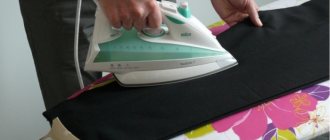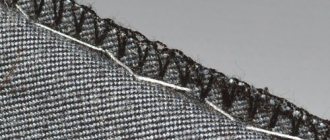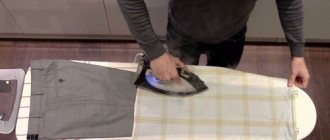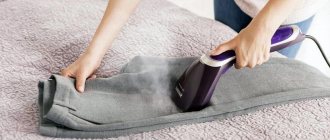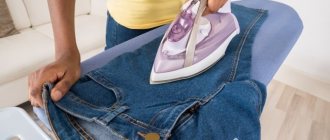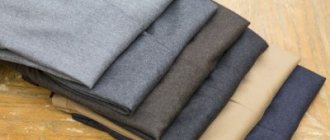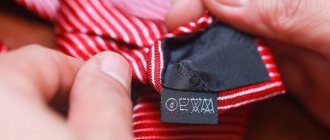We owe the appearance of trousers with creases to traders and manufacturers. A couple of centuries ago, clothes were made in factories and then transported by ship overseas. To accommodate more things in the hold, the trousers were folded and placed very tightly in boxes. It was not possible to smooth out the wrinkles that appeared as a result of transportation. I had to look for a way out. We came up with the idea of folding the trousers so that the same folds were obtained on the front and back. The new look quickly became fashionable and was loved by the people.
How to iron trousers: the necessary technique and algorithm of work
In order to properly iron your trousers, you will need a good iron and a properly organized ironing area. Without all this, you won’t be able to get rid of folds and bruises, or make beautiful, even arrows. Ideally, the iron is equipped with a temperature switch and a steam supply system. If you have an old Soviet iron, it’s also not a problem. In this case, always use damp gauze, folded several times. If you are the happy owner of a vertical steamer, then with its help you will be able to smooth out even the most difficult bruises right on the spot.
Using a special attachment you can make straight arrows without distortions
It is better to iron trousers on an ironing board, but it can be quite successfully replaced with a kitchen table covered with a thick blanket. Auxiliary items will also come in handy:
- ironer;
- tailor's pins or stationery clips (binders);
- spray bottle with water;
- terry towel;
- sheets of cardboard or thick paper.
Trousers, like other types of clothing, are recommended to be ironed from the inside out or through an iron. This will protect the fabric from the formation of lasses, shine and scorching. Pins and clips are useful when ironing creases, as they are used to secure the instep and side seams. A spray bottle is used to additionally moisten the fabric so that folds can be ironed out better, and a terry towel makes ironing some hard-to-reach places easier. A sheet of cardboard is placed under the burlap pockets or seams so that they do not print on the outside of the trousers after ironing.
To iron trousers you will need an iron, ironing board, ironing iron and clips
Temperature conditions for ironing trousers made of different fabrics
Before you start ironing, you need to read the information on the label. The fabric composition and care recommendations should be indicated there. Depending on the material, you need to choose the optimal temperature regime.
The label shows pictograms indicating ironing parameters and product care
Knowing the composition of the fabric, it will be easier to select the correct temperature setting on the thermostat:
- wool, mixed fabric - wool mode, number 2 or two dots;
- polyester - silk, nylon mode, number 1 or one dot;
- cotton, linen — mode cotton, linen, number 3 or three dots;
- cotton + synthetic - iron like wool, but with pressure.
The wool is not ironed with pressure, but steamed, barely touching the fabric with the sole of the iron. Cotton and linen are ironed with pressure using a damp iron. Synthetic fabrics are ironed at a minimum temperature only through gauze. If it was not possible to determine the composition of the fabric, then ironing begins from the inside out at the hem of the trousers.
The type of fabric is also taken into account. If there is lint, the product should be ironed, if possible, only on the reverse side. If this is not enough, then the iron is moved in the direction of the pile, that is, from top to bottom, barely touching the surface of the fabric.
Table: recommended ironing parameters for different types of fabrics
| Material | Steam quantity | Steam quality | Temperature, °C | Features of the iron |
| Cotton | Average | Wet | 180–220 | Need pressure |
| Linen | A lot of | Wet | 215–230 | Need pressure |
| Cotton + linen | A lot of | Wet | 180–220 | Need pressure |
| Wool | A lot of | Wet | 160–170 | With steaming |
| Polyester | Very little | Very dry | 160–200 | Without water |
| Cotton + synthetic | Average | Dry | 160–170 | Ironer |
| Wool + synthetic | Average | Little moisture | 160–180 | Ironer |
| Cotton corduroy | Average | Less humid | 180–190 | Hem movement |
Ironing algorithm for classic trousers with arrows
Trousers are ironed in the following sequence:
- Turn it inside out.
- First they iron the upper part: the burlap of the pockets, underneath them.
Burlap trousers are ironed from the inside out - To ensure that the trousers fit well on the figure and do not wrinkle at the seams, press the side and crotch seams. The side seam is ironed from the waist down, the step seam is ironed from the bottom of the trousers upward.
- The trousers are turned on the face.
- Unfasten the zipper, open its different sides and iron the middle seam. Stroked in the buttocks area.
To iron the middle seam of the trousers, you need to open the zipper - Iron the belt first on the front half, and then on the back.
The trouser waistband is ironed from the outside - If there are folds that turn into arrows, then we also pay attention to them.
- Iron side and back pockets.
Side pockets are ironed from the front side, pulling the trousers onto the ironing board - Place a folded towel inside the trousers or put it on the edge of the board.
- Iron the codpiece and the front of the trousers.
The codpiece is ironed with the tip of the iron - Fold the trousers in half and begin to form the creases.
- After finishing work, the trousers are allowed to cool for 15 minutes, or preferably several hours.
General recommendations
Wool trousers can differ in style, size, and are intended for men or women. However, there is a general set of recommendations, following which will help you get rid of wrinkles quickly and efficiently:
- the ironing board should not have any damage or lumps under the fabric;
- Before ironing, clothes must be checked for stains and removed in a timely manner, otherwise the dirt will penetrate deeper into the fibers of the fabric and it will be much more difficult to get rid of them;
- It is advisable to fill the iron, as well as the spray bottle, only with clean distilled or filtered water, otherwise yellow stains may appear on the clothes, which are almost impossible to remove.
If you are ironing an item for the first time, be sure to study the manufacturer’s recommendations on the tag. As a rule, woolen items are ironed at low temperatures, without applying strong pressure to the iron, so as not to damage the pile.
How to make creases on trousers
For an inexperienced housewife or a single man, ironing perfectly even arrows is quite difficult. If you don’t want to spend money on dry cleaning every time, you should learn all the intricacies of flawless ironing. There are two important points here: how to fold the trouser legs correctly and where, in fact, these arrows should be located.
How to fold trousers correctly and where the arrows should be
To form perfect creases without distortions, it is important to fold your trousers correctly. The product is folded in half along the middle seam. The trouser legs are aligned so that the crotch seams completely coincide with the side seams. Make sure that the lines of the side seams coincide in the upper part of the trousers (look at the edges of the belt). If the trousers are cut correctly, when the seams are aligned, the front crease will start exactly at the end of the front dart or pleat.
To correctly form the arrows, you need to fold your trousers correctly
The arrows seem to “cut” the front and back halves of the trousers into two equal parts. Depending on the type of trouser, the front part may start with a dart or a pleat. If the trousers have two folds, then the fold that is located closer to the codpiece becomes a crease. As for the back half, the arrow ends somewhere at the level of the end of the back dart or the inner edge of the pocket, but does not reach the waistband. The back half of the trousers is always ironed after the first. The arrow on it is formed quite easily, but only after you have properly ironed the front one.
Photo gallery: where the arrows are located on different models of men's and women's trousers
In such trousers, the front pleats turn into arrows
The arrows start at the ends of the front darts
Front arrows start from the fold
Many models of women's trousers also have arrows
Is there a difference between ironing women's and men's crease trousers?
There is no significant difference in the ironing of women's and men's models. Ironing follows the same algorithm: first they iron from the inside, then the upper part from the “face” and finally begin to form the arrows. The only difference may be in the ironing technique. Women's trousers can be tapered or almost fitted. In this case, when ironing the internal seams, place a rolled up terry towel inside the trouser leg or pull the same trouser leg onto a board for ironing the sleeves. This is done in order not to break the fold line of the arrow and not to make a fold from the inside.
You also need to take into account the fact that not all models of women's trousers have arrows that reach the waist.
Arrows on women's trousers visually lengthen the legs
How to iron arrows correctly
So, you have done half the work and all that remains is to iron the arrows. Do the following:
- Fold the trousers in half, aligning them along the inseam and side seams.
- Secure the trousers at the waist using a clip or pins (if the fabric is not too thin and the holes will not be visible).
It is better to fasten the trouser waistband using office clips - Turn the top leg to the side.
The arrows are ironed on each trouser leg separately - Pin at the bottom, once again checking that the seam lines line up.
Using office clips, you can fix the bottom of the trousers and then the seams will not fray during ironing - If the trousers are lined, be sure to push it out as far as possible.
- Cover the bottom leg with an iron and moisten with water from a spray bottle.
The ironing net greatly facilitates the process of forming creases on trousers - “Mark” the line of the front arrow: apply the iron in turn, first in the knee area, then in the upper part and finally in the lower part.
- After this, boldly iron the creases from top to bottom, slightly pulling the trouser leg with your free hand.
First, iron the crease on the front half of the trousers. - Iron the crotch seam.
- Proceed to form the back arrow in the same way, only iron it in the opposite direction - from bottom to top.
The crease on the back half of the trousers is ironed only after the crease has been made on the front. - Turn the trouser leg over to the other side and iron it again.
- Let the trouser leg cool slightly (15 minutes).
- Turn the trousers over to the other side so that the unironed part is on the surface and the ironed part is to the side.
- Form the arrows in the same way.
- Fold the trousers in half so that both legs lie on top of each other, and iron again on both sides.
To consolidate the result, both halves of the trousers are ironed together. - Let the product cool for an hour.
- Hang your pants on a hanger or put them on.
You don’t need to use an iron if you have a high-quality steam iron with a ceramic sole, and the fabric from which the trousers are made lends itself well to wet-heat treatment and is resistant to the appearance of shine.
How to keep creases on trousers before washing
Forming smooth, beautiful arrows without “doubling” and distortions is a painstaking task and requires skill. Therefore, it is quite natural to want to maintain this effect at least until the next wash. There are several tricks that will help fix the arrows for a long time:
- A piece of soap. Using soap, draw an arrow line from the inside. Then the product is turned inside out and ironed with steam.
- Vinegar solution. For a liter of water you will need a tablespoon of vinegar. The solution is sprayed onto the ironing iron or poured into a tank of water and ironed with “vinegar” steam. The bend of the hands is clear, even and resistant to deformation.
- Starch solution. Take a teaspoon of potato or corn starch per liter of cold water. Boil over heat for 2 minutes and then allow to cool to room temperature. The ironing iron is moistened in the resulting solution. Use only for linen and cotton fabrics in light shades.
By the way, the vinegar solution prevents the appearance of shine and shine on the fabric. Thus, by using vinegar when forming creases, you also protect your trousers from the formation of unsightly shiny spots.
Video: how to iron creases on trousers and how to make them durable
Removing shine from trousers
When trying to iron creases on men's trousers, many are faced with the problem of the appearance of an unsightly shine. You can avoid shiny marks on your trouser legs by following two important rules:
- We start ironing from the wrong side.
- We use an ironing iron while forming the arrows. During the process of ironing trouser legs, this special mesh (gauze, cotton fabric) must be constantly moistened with water or a weak vinegar solution in the ratio: 1 tsp. essences per 1 liter of water.
Correcting ironing errors: marks, marks, double arrows
Unfortunately, we often forget to use the iron and unsightly shiny spots remain on the fabric. Fortunately, in most cases these problems can be fixed.
How to remove shine and shine
Laces are the shiny marks left by the soleplate of an iron. They are most noticeable on dark fabrics made from natural, mixed and synthetic fibers. The problem can be resolved in the following ways:
- If the fabric is made of cotton or linen, then lasses are almost always removed by steaming through a damp iron.
- If the fabric is mixed, you will need to prepare a solution of water, vinegar and a few drops of liquid soap. Moisten gauze in the solution and iron the problem area through it until the stain completely disappears.
- Ammonia will help remove shine from woolen fabrics. A few drops of ammonia are diluted in a liter of water. Then proceed in the same way as in the first method.
- Lass on synthetic fabrics is removed with gasoline. A cotton pad is soaked in the product, and then the stain is treated with it. After this treatment, the product is washed and dried naturally.
- Shine from dark suit fabrics is also removed with unsweetened black tea: moisten a cotton swab and treat the stain.
- You can also re-wash your pants and add fabric softener when rinsing.
If you are unable to remove the lasses yourself, you should take your trousers to the dry cleaner. In the case of synthetic fabrics, it also happens that the shine from the iron remains. In this case, the trousers are ruined forever.
Video: how to remove shine from an iron from trousers
How to remove scorch marks from an iron
Tan marks are yellow spots that are most noticeable on white, light-colored and colored fabrics. They are more difficult to eliminate than lasses. For these purposes, the following methods are used:
- Lemon and powdered sugar. Rub the stain with a slice of lemon and sprinkle with powdered sugar. Allow it to dry, and then partially wash the treated area or wash the product completely.
- Onion gruel. Apply onion pulp to the scorched area and leave until completely dry. Then wash and dry as usual. You can also use onion halves and rub them thoroughly onto the stains.
- Vinegar and salt. Make a solution of 9% vinegar and water in equal proportions. The scorched area is soaked in the solution and then sprinkled with salt. After the fabric has dried, the product is washed.
- 3% hydrogen peroxide. Use only on white fabrics. Peroxide is applied to a cotton swab and the area with the tan is treated. After the treated area has dried, rinse it in cold water.
If you are unsure of your abilities and are afraid of completely ruining your trousers, then immediately contact the dry cleaner.
How to eliminate double arrows
It is not always possible to make correct single arrows the first time. If during ironing the trousers slid along the ironing surface, then it is likely that double creases will form, which will obviously not please the person who is going to wear these trousers. Fortunately, it is much easier to remove “homemade” arrows than stable industrial ones formed under a special press. Do the following:
- Turn your pants inside out.
- Lay out so that the arrows are in the middle of the trouser leg.
- Moisten the gauze thoroughly and place it on the problem area.
- Iron until the arrows disappear.
The disadvantage of this method is that, most likely, you will get rid of the “factory” arrow and will have to form it again. We advise you to first try to fold the trousers correctly so that the seams match, and then iron them well with steam. Perhaps the extra arrow will disappear. You can also wash your trousers and then try to iron them better.
You can try to eliminate the extra arrow by ironing it through a wet cloth.
Temperature selection
There are rules for ironing trousers made from various types of material. Selecting the temperature setting will protect the fabric from damage. Each product has a label indicating acceptable care methods.
| Material | Temperature conditions, recommendations |
| Suit fabric | You can iron at 200 degrees, do not be afraid to treat with hot steam. |
| Durable cotton | The material can withstand temperatures up to 170 degrees. It's better to moisten first. |
| Knitwear | Heat the iron to medium or use a steam generator in a vertical position. |
| Linen | Iron the arrows at 200 degrees. |
| Wool-blend material, wool | Experts advise using steaming in a vertical position. Set the sensor to 100 degrees. |
| Viscose | It is allowed to moisten the fabric and set the temperature no higher than 120 degrees. |
| Delicate silk, twill, satin | Iron without steam. Do not use wet padding. |
Reviews from those who have ever made creases on their trousers
Every housewife has her own secrets for ironing trousers with creases, and some of them are happy to share them on online forums. Below are the most interesting and useful of them.
Here, housewife Veronica from Rostov-on-Don shared with other forum participants how she makes arrows:
And Muscovite Elena advises first ironing the creases in the usual way on an ironing board, and then steaming the trousers while hanging:
An anonymous guest on the Woman.ru forum advises not to bother at all and to stroke the old arrows:
I, as the author of this article, also want to share my experience of ironing classic men's trousers. To do this, I always use gauze folded several times. My iron is good, with a ceramic sole, and even has a vertical steam supply. But still, I always prefer to use a damp iron - the result is much better. Sometimes I use a simple cotton fabric or a thin terry towel. I wet the iron in a weak vinegar solution. Thanks to it, the arrows are preserved for a long time and even withstand repeated squats and standing up from a chair during the working day. I iron the trouser legs one at a time, since making arrows on both at the same time is aerobatics for me. So, I make a front crease, moving from the fold in the waistband to the bottom edge. I iron the entire trouser leg, not reaching the place where the back arrow should be. Then I shake it well and start ironing the second arrow. I do the same thing, only I move from the bottom up: I iron to the place where I can still iron the arrow. I usually have the end of the back dart in the same place where the back pocket begins. Then I turn the same pant leg over to the other side and iron it again. I leave the trousers alone for about 20 minutes and then start ironing the second half. At the end, I fold both trouser legs together and iron them again on both sides. The arrows turn out even and neat.
Steam clothes instead of ironing
It used to be a little difficult with thick things. It took a lot of work to give them a neat look. However, today the problem is easily solved with the help of a steamer.
It is used to make things easy to iron, and also in cases where ironing is not allowed.
If there is not enough time for all the procedures, the product is taken by the corners, shaken and hung on a rope. Then, after drying, it will look good even without hot ironing.
Nylon fabrics cannot be ironed, so they are straightened or hung out.
Let us now consider how ironing of linen and individual items occurs.
Is it possible to do without an iron?
Steamer for ironing trousers
What to do if you need creases on your trousers, but an iron is not available? In this emergency situation, regular steam and weights will help. As a source of steam, you can use boiling water in an electric kettle or a hot shower in a shower stall. To fix the fold, the trousers must be folded lengthwise, making sure that the side and crotch seams match, and lay them on a flat surface under a press or mattress overnight.
What you need to know
To remove the arrows, you will need an iron and ironing board, as well as a little time and patience. First, you need to find a label on the fabric with information from the manufacturer about the intended washing and ironing conditions. The label has the following symbols:
- The three-point iron allows ironing at temperatures starting from 200°C.
- Two points allow heating to no more than 150°C.
- One point recommends not to exceed 110°C.
- The image of crossed out steam from the iron allows you to iron only without steam.
If there is no label, start with minimal heat, gradually starting to increase the temperature. You cannot iron a product at a high temperature; the fabric can be damaged; at best, stains will appear from areas ironed at a high temperature.


